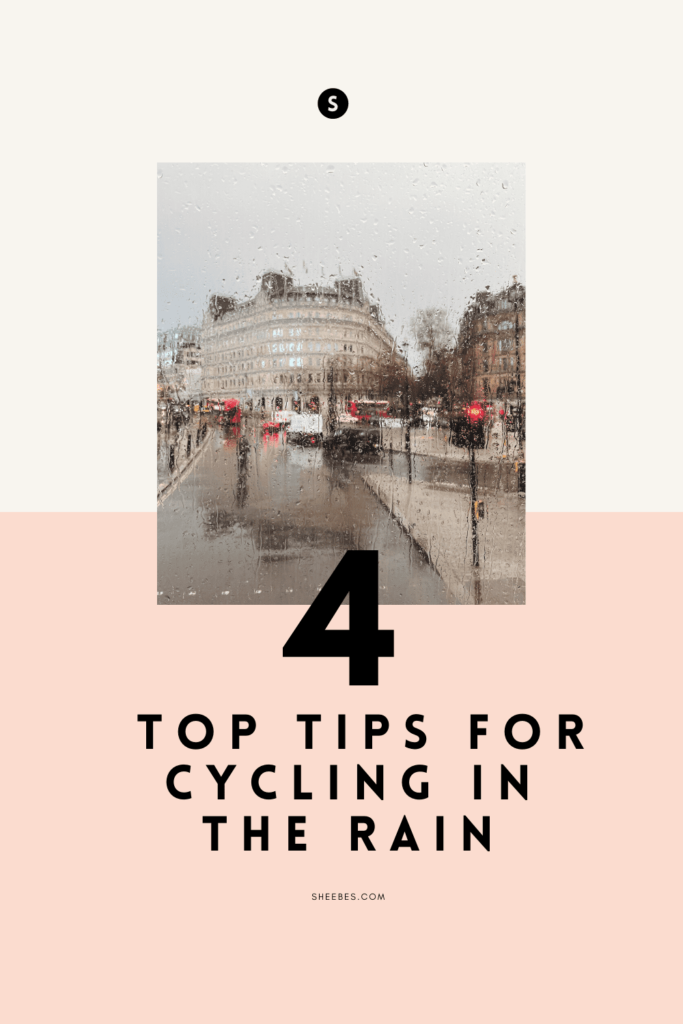Cycling in the rain can be intimidating for even the most experienced cyclists, but with the appropriate rainy-day cycling gear, you can stay dry during rainy rides.
Today, we’ll dive into four tips for cycling in the rain, including:
- The rain gear you’ll need for your bike
- How to adjust your bike handling technique
- The essential biking in the rain gear to keep you dry
- And finally, how to make yourself noticeable on the road.
Let’s dive into the tips for cycling in the rain.

Whether you’re a runner looking for running tips or a cyclist searching for cycling advice, this site is here to help you elevate your fitness game.
Affiliate Disclosure: I’m here to help you grow as a rider and runner. So to keep things running smoothly and the content free, I participate in the Amazon Services program and select affiliate networks. So, when you click on those affiliate links, I earn a small commission at no extra cost to you.
HOW TO BIKE IN THE RAIN | 4 TIPS FOR CYCLING IN THE RAIN

The rain gear for cycling you’ll need for your bike
1| Use bike fenders. Bike fenders, or mudguards, cover the top of your tires, and depending on the bike fender, you’ll either attach them to your bike frame or saddle.
You’ll want to use bike fenders to keep mud from flying from your wheel and onto your back and your bike’s drivetrain. You’ll stay drier and cleaner than if you went without fenders.
Fenders that cover most of your tire will shield you the most from rain and mud when you’re biking in the rain.
So what bike fender should you get?
Unfortunately, I can’t point you to the best bike fender because there’s no universal fender size. The bike fender you’ll need depends on your bike.
As you search for bike fenders, keep in mind:
- Be sure to look for fenders wider than your tires to prevent your tires from rubbing against the fender. Look for your tire width on the side of your bike tires, then look for a fender that’s at least 8mm wider than your bike tire.
- You’ll also need enough clearance between your tire and bike frame to fit your fenders.
2| Lower your tire pressure to 85 to 90 psi to give your tires more surface area in contact with the road.

Change your bike handling technique when you’re cycling in the rain
Oil buildup from vehicles rises to the surface when it rains, making the roads as slippery as ice, and these cycling in the rain tips can help you ride your bike on slick roads.
- Remember to look ahead instead of at your front wheel to help you avoid sudden, hard stops so that you don’t slip and crash.
- Swing wide around corners or curves in the road to stay upright on your bike.
- Painted lines on the road, steel covers, and leaves become much slicker when it rains, so avoid them if possible.
- Ride around puddles, not through them. You won’t know what’s underneath standing water (it may be a pothole) until it’s too late. So if you can’t see through the water, ride around it.

Stock up on biking in the rain gear that will keep you dry
Cycling rain jacket. Your bike riding preference will determine what type of rain jacket you should get.
What kind of rainy-day cyclist are you?
Will you venture out when it’s pouring rain? A waterproof, breathable rain jacket will be your best bet.
Combining waterproofing and breathability is a tricky balance and uses technical fabric, so this type of cycling rain jacket is pretty expensive. (Here are two examples of waterproof cycling jackets: men’s waterproof cycling jacket, women’s waterproof cycling jacket)
Or will you only ride in the rain because you got caught in it?
You’ll need a just-in-case water-resistant rain jacket that’s packable and light enough to fold into your jersey pocket. (Some examples: women’s packable jacket, men’s packable jacket)
A water-resistant cycling jacket will keep light rain off of you, for a short while. But, if you’re caught in the pouring rain, water-resistant jackets won’t be up to the task.
Don’t want to buy another cycling jacket? You can use a water-repellent coating spray to make your jacket water-resistant.
This spray won’t transform your jacket into a waterproof one, but it can keep light rain off you for a short while. This coating spray wears off after some time, and you’ll need to reapply once you notice that the water isn’t beading up and rolling off.
Cycling rain pants (trousers) keep the water out and they’re generally relaxed and roomy, so you pull them easily over your bike shorts.
Cycling rain pants, like cycling rain jackets, have various levels of waterproofing and breathability abilities.
If you want to stay totally dry, look for cycling rain pants (like this one) made of waterproof fabric with sealed seams.
Waterproof overshoes, worn over cycling shoes (like this one) will insulate your feet from the cold and rain.
Waterproof socks, if you’re not into overshoes and you don’t mind getting your cycling shoes wet. These socks are thicker than your usual sock, so be sure to check if you’ll be able to fit into your cycling shoes.

Make yourself noticeable when you’re biking in the rain
A bike headlight (like this rechargeable one) signals your presence to other vehicles, helps you see in low-light conditions, and can reduce your probability of getting into a bike accident. 1
Choose a flashing rear bike light instead of a steady one to make you stand out up to 2.4 times more than a rider with no lights and up to 1.4 times more than someone using only a steady light. 2
Wear a bright waterproof helmet cover to keep your helmet and head dry and to stand out from your environment.
Place reflective bands on your ankles and knees. Reflective bands (like these) reflect light from vehicles, making you noticeable on the road. For maximum visibility and safety, wear the bands on the parts of your body that move the most (your ankles and knees) because movement attracts attention.
I hope these cycling in the rain tips have inspired you to get outside and ride in the rain. By using fenders, adjusting your tire pressure, changing your bike handling technique, and stocking up on biking in the rain gear, you can stay dry and comfortable on your rainy rides.
